Hydrogen-Enriched Compressed Natural Gas Network Simulation for Consuming Green Hydrogen Considering the Hydrogen Diffusion Process
Abstract
:1. Introduction
- (1)
- A power flow calculation model for the isothermal steady-state natural gas network is established and solved by the finite element node method, which provides initial calculation values of gas pressure and flow rate for the hydrogen diffusion dynamic simulation of hydrogen injection in the natural gas network.
- (2)
- For three types of renewable energy power production scenarios of hydropower stations, wind farms, and PV power stations, the mathematical model of the surplus electric power that can be used for hydrogen production by water electrolysis for each type is established. Among them, hydropower output is related to the head, water flow rate, and unit efficiency, and the output can be considered stable within a dispatching day; wind power output considers the superposition of four velocities of base wind velocity, gust wind velocity, ramp wind velocity, and noise wind velocity; PV power output considers the superposition of the two components of the intraday light component and the random weakening component.
- (3)
- The effects of two factors, convection, and diffusion, on the dynamic change process of hydrogen concentration are analyzed. The convection–diffusion model with variable diffusion coefficient considering the change of diffusion coefficient and the convection–diffusion model with constant diffusion coefficient suitable for convection-dominated scenarios are established; solving methods based on the central difference and upwind difference scheme are proposed.
- (4)
- The dynamic distribution of hydrogen concentration in pipelines under different hydrogen injection modes is simulated on a seven-node natural gas network. Based on the simulation analysis, the hydrogen blending simulation of the studied natural gas network belongs to the convection-dominated problem, so the convection–diffusion model with constant diffusion coefficient is adopted to solve it. In addition, the upwind difference scheme is chosen to solve the simulation model. Although the truncation error is high, the negative hydrogen concentration caused by the central difference scheme can be avoided.
- (5)
- To compare the influence of different renewable energy output characteristics on the distribution of hydrogen concentration and the safety of pipeline operation, hydrogen blending stations using hydropower, wind power, and solar power to produce hydrogen are set up at three nodes in the natural gas network. Furthermore, three scenarios of “high penetration of solar power”, “high penetration of wind power”, and “balanced penetration of solar power and wind power” are set up, respectively. The simulation results show that in the solar-power-dominated scenario, the hydrogen concentration exceeds the limit for more time and the overall hydrogen production is low. In contrast, hydropower and wind power are more compatible with hydrogen production by water electrolysis, and the hydrogen concentration in natural gas pipelines is more evenly distributed.
2. Steady-State Simulation of Natural Gas Network
2.1. Modeling of Isothermal Steady-State Natural Gas Network
2.2. Solving Method
3. Modeling of Hydrogen Production in Different Scenarios
3.1. Power Output of Hydropower Station
3.2. Power Output of Wind Farm
- The base wind velocity VA can be approximated by the Weibull distribution parameter, which is derived from the wind measurement data of the wind farm.
- b.
- For the gust wind velocity VB, the abrupt change of wind velocity can be expressed by (19):
- c.
- For the gust wind velocity VB, the abrupt change of wind velocity can be expressed by (19):
- d.
- For the noise wind velocity VD, the randomness is generally represented by random noise, as shown in (21):
3.3. Power Output of PV Power Station
- The intraday light component SA describes the process of the light intensity changing from weak to strong and then weak again in a day, which can be expressed by (24):
- b.
- The random weakening component SB describes the change of light intensity caused by the meteorological factor of dark clouds and is simulated using random number generation. Divide the time from sunrise to sunset into equal parts, and generate random numbers for each part to simulate whether dark clouds appear. Then, the light intensity of part i can be calculated by (25):
4. Dynamic Simulation of Hydrogen Concentration in Natural Gas Network
4.1. Fundamental of Fluid Dynamics
4.1.1. Convection
4.1.2. Diffusion
4.2. Hydrogen Diffusion Model Based on Convective–Diffusion Equation
4.2.1. Convective–Diffusion Model with Variable Diffusion Coefficient
4.2.2. Convective–Diffusion Model with Constant Diffusion Coefficient
4.3. Changes of Diffusion Coefficient in HCNG
4.4. Solving Method
4.4.1. Central Difference
4.4.2. Upwind Difference
4.5. Overall Simulation Process
5. Case Study
5.1. Case Description
5.2. Steady State Simulation of the Natural Gas Network
5.3. Simulation Model Validation—Single Pipe Example
5.4. Simulation Results of Differernt Hydrogen Production-Blending Scenarios
5.4.1. Scenario I: High Penetration of Solar Power
5.4.2. Scenario II: High Penetration of Wind Power
5.4.3. Scenario III: Balanced Penetration of Solar Power and Wind Power
5.4.4. Comparison and Analysis of the Three Scenarios
- (1)
- Scenario I: The light resources were relatively sufficient and the wind resources were relatively poor. The hydrogen concentration of Pipe 3 and Pipe 4 did not exceed the limit, but the hydrogen concentration of Pipe 5 and Pipe 6 exceeded the limit to a certain extent due to the light intensity at noon, and it happened nearly 50% of the time in a day. In addition, the problem of the hydrogen concentration violation was most serious in Scenario I, while the average hydrogen concentration level of the whole network was the lowest throughout the simulation period.
- (2)
- Scenario II: The wind resource was relatively sufficient, and the light resource was relatively poor. When the hydrogen concentration in the system was at its highest, it was close to the upper limit but did not exceed the limit, and the system was in a safe operation state all the time.
- (3)
- Scenario III: Lighting resources and wind resources were relatively balanced, and the hydrogen concentrations of Pipe 3 and Pipe 4 still did not exceed the limit. Similar to Scenario I, the hydrogen concentration in Pipe 5 and Pipe 6 exceeded the limit at noon and partly during periods in the afternoon. However, the hydrogen concentration in Pipe 5 and Pipe 6 exceeded the limit for a significantly shorter period of time than in Scenario I.
- (1)
- Solar power was greatly affected by the light intensity in the day, and too much hydrogen production near the peak of light intensity could easily lead to the hydrogen concentration violation. Meanwhile, the overall hydrogen production by solar power was relatively low, which classifies the hydrogen production mode into an uneven one. When the surplus renewable energy was mainly solar power, absorbing it with hydrogen production by water electrolysis showed certain limitations, which may bring risks to the safe and stable operation of natural gas pipelines.
- (2)
- Compared with hydrogen production by solar power, hydrogen production by hydropower and wind power were relatively stable hydrogen production modes. Among them, hydropower was the most stable and adjustable, and the output could even be considered unchanged within a dispatching day. Compared with solar power, wind power could produce a higher overall hydrogen amount in one day, and the difference between the wind peak and the wind valley was not that large. It was a relatively even hydrogen production mode. In conclusion, it is highly feasible to absorb surplus wind power using hydrogen production by water electrolysis.
- (3)
- By virtue of the instinctive complementary characteristics of solar and wind power, the solar–wind power balance scenario can improve the problem of hydrogen concentration exceeding the limit in the solar-power-dominated scenario. In addition, the renewable energy that can be used for hydrogen production is also related to the characteristics of local electricity demand. The design and dispatch of local hydrogen production-blending systems need to comprehensively consider the complementary characteristics of solar and wind power, as well as the matching between the renewable energy generation and local electricity load.
- (4)
- The simulation research in this paper did not consider the energy storage technology. If equipped with the electricity storage and gas storage technologies, the problems of power to hydrogen (P2H) and pipeline transportation of HCNG could be better matched. From another perspective, the simulation work in this paper also demonstrated the necessity of planning and designing energy storage facilities when carrying out hydrogen blending of natural gas pipelines in areas where solar power is dominant.
6. Conclusions
- under the solar-power-dominated hydrogen production-blending scenario, the overall hydrogen production is low while the hydrogen concentration exceeds the permitted limit for nearly 50% of the time in a day;
- the hydrogen concentration in each pipeline of the natural gas network does not exceed the limit in the wind-power-dominated scenario;
- in the solar–wind power balance scenario, the overrun time of the hydrogen concentration in Pipe 5 and Pipe 6 decreases to 91.24% and 91.99% of the solar-power-dominated scenario.
- hydrogen production by hydropower and wind power are relatively stable hydrogen production modes compared with that by solar power;
- the instinctive complementary characteristics of solar and wind power as well as the local electrical load curve deserve attention to smooth the hydrogen concentration distribution in natural gas pipelines.
Author Contributions
Funding
Institutional Review Board Statement
Informed Consent Statement
Data Availability Statement
Acknowledgments
Conflicts of Interest
Nomenclature
| A | Node-pipeline matrix, dimensionless |
| aij | Element of A |
| Awt | Area swept by the wind turbine blades, m2 |
| Apv | Area of PV panels, m2 |
| Awb | Scale parameter of Weibull distribution, dimensionless |
| B | Loop-pipeline matrix, dimensionless |
| bnj | Element of B |
| Cm | Hydrogen concentration, kg/m3 |
| Cwind | Wind energy utilization coefficient, dimensionless |
| D | Diffusion coefficient, m2/s |
| d | Inner diameter of the pipe, mm |
| F | Turbulent scale, m |
| fm | Mass fraction which varies between 0 and 1, dimensionless |
| fv | Volume fraction which varies between 0 and 1, dimensionless |
| G | Diagonal admittance matrix, dimensionless |
| gij | Element of G |
| H | Effective head, m |
| J | Diffusion flux, kg/m2·s |
| KN | Surface roughness coefficient, 0.004, dimensionless |
| Kwb | Shape parameter of Weibull distribution, dimensionless |
| L | Length of the pipe, m |
| MA, MB | Molecular weights of components A and B, g/mol |
| N | Convection flux, kg/(m2·s) |
| Nsam | Number of spectral sampling points, dimensionless |
| p | Total pressure, Pa |
| Phydro,out | Power output of the hydropower station, MW |
| Phydro-H | Hydropower output that can be used to produce hydrogen, MW |
| Maximum output of the hydropower station integrated into the grid, MW | |
| Psolar,out | Power output of the PV power station, MW |
| Psolar-H | Solar power output that can be used to produce hydrogen, MW |
| Maximum output of the PV power station integrated into the grid, MW | |
| Pwind,out | Power output of the wind farm, MW |
| Pwind-H | Wind power output that can be used to produce hydrogen, MW |
| Maximum output of the wind farm integrated into the grid, MW | |
| Q | Branch flow vector, m3/s |
| Qwater | Water flow rate, m3/s |
| S | Pipeline flow resistance coefficient matrix, dimensionless |
| SA | The light component of light intensity, W/m2 |
| SB | The random weakening component of light intensity, W/m2 |
| Ssolar | Light intensity, W/m2 |
| Maximum light intensity statistical value under certain local weather, W/m2 | |
| T | Fluid Temperature, K |
| t | Index to time, min |
| Tn | Absolute temperature under standard conditions, 273.15 K |
| T1G | The time when the abrupt change starts, min |
| TG | The change period, min |
| T1R | Start time of the gradual change, min |
| T2R | End time of the gradual change, min |
| TR | Holding time after the gradual change, min |
| Tr | Sunrise time, min |
| Td | Sunset time, min |
| u | Fluid velocity variable that varies along the pipeline, m/s |
| VA | Base wind velocity, m/s |
| VB | Gust wind velocity, m/s |
| VC | Ramp wind velocity, m/s |
| VD | Noise wind velocity, m/s |
| Vwind | Wind velocity acting on the wind turbine, m/s |
| x | Index to pipeline length, m |
| Xi | A parameter that obeys the Bernoulli distribution, dimensionless |
| Z | Compressibility factor, dimensionless |
| ηhydro | Efficiency of the power station unit, dimensionless |
| ηm | Efficiency of MPPT, dimensionless |
| ηpv | Efficiency of PV panels, dimensionless |
| γ | Specific weight of water, 9810 N/m3 |
| Γ | Gamma function, dimensionless |
| ωi | Angular frequency of sampling point i, rad/s |
| φi | A random variable obeying a uniform distribution between [0, 2π], rad/s |
| μ | Average wind velocity at the relative height, m/s |
| ρ | fluid density, kg/m3 |
| ρair | Air density, kg/m3 |
| λ | Friction resistance coefficient of pipelines, dimensionless |
| λl | Weakening degree of the cloud to the light intensity, dimensionless |
| θ | Angle of incidence of PV panels, ° |
| α | Fluid velocity, m/s |
| v | Gas flow rate, m/s |
| ξ | A parameter that is only related to temperature and gas species, Pa·m2/s |
| κ1 | The empirical constant for low pressure networks, dimensionless |
| κ2 | The empirical constant for medium and high pressure networks, dimensionless |
| Δω | Sampling step size, rad/s |
| Δpab | Pressure drop between node a and node b, Pa |
| ΣVA, ΣVB | Molecular diffusion volumes of components A and B, cm3/mol |
Appendix A
| Pipe No. | Start Node | End Node | Length (m) | Diameter (mm) | Pipeline Flow Resistance Coefficient |
|---|---|---|---|---|---|
| 1 | 7 | 1 | 27,000 | 660 | 0.01 |
| 2 | 1 | 2 | 22,500 | 660 | 0.015 |
| 3 | 2 | 4 | 18,000 | 500 | 0.005 |
| 4 | 2 | 3 | 18,000 | 500 | 0.01 |
| 5 | 4 | 5 | 36,000 | 330 | 0.02 |
| 6 | 4 | 6 | 27,000 | 330 | 0.015 |
| Node No. | Gas Load (m3/s) |
|---|---|
| 1 | 0 |
| 2 | 0 |
| 3 | 0 |
| 4 | 0.18 |
| 5 | 0.13 |
| 6 | 0.09 |
| 7 | 0 |
Appendix B
| Gust Wind Velocity No. | Start Time | Duration | Maximum Wind Velocity (m/s) |
|---|---|---|---|
| 1 | 4:00 | 6 h | 0.4 |
| 2 | 14:00 | 6 h | 0.3 |
| 3 | 22:00 | 1.5 h | 0.2 |
| Ramp Wind Velocity No. | Start Time | End Time | Hold Time after Ramp | Maximum Wind Velocity (m/s) |
|---|---|---|---|---|
| 1 | 3:00 | 16:00 | 5 h | 0.7 |
| Sunrise Time | Sunset Time | Maximum Light Intensity Statistical Value (Lux) |
|---|---|---|
| 5:30 | 17:30 | 27,000 |
Appendix C
| Gust Wind Velocity No. | Start Time | Duration | Maximum Wind Velocity (m/s) |
|---|---|---|---|
| 1 | 3:00 | 7 h | 0.4 |
| 2 | 12:00 | 8 h | 0.4 |
| 3 | 20:00 | 4 h | 0.2 |
| Ramp Wind Velocity No. | Start Time | End Time | Hold Time after Ramp | Maximum Wind Velocity (m/s) |
|---|---|---|---|---|
| 1 | 1:00 | 5:00 | 6 h | 0.9 |
| 2 | 12:00 | 18:00 | 5 h | 1.1 |
| Sunrise Time | Sunset Time | Maximum Light Intensity Statistical Value (Lux) |
|---|---|---|
| 5:30 | 17:30 | 15,000 |
Appendix D
| Gust Wind Velocity No. | Start Time | Duration | Maximum Wind Velocity (m/s) |
|---|---|---|---|
| 1 | 3:00 | 7 h | 0.4 |
| 2 | 12:00 | 8 h | 0.35 |
| 3 | 20:00 | 4 h | 0.2 |
| Ramp Wind Velocity No. | Start Time | End Time | Hold Time after Ramp | Maximum Wind Velocity (m/s) |
|---|---|---|---|---|
| 1 | 1:00 | 5:00 | 6 h | 0.8 |
| 2 | 12:00 | 18:00 | 5 h | 1 |
| Sunrise Time | Sunset Time | Maximum Light Intensity Statistical Value (Lux) |
|---|---|---|
| 5:30 | 17:30 | 21,000 |
References
- Ogden, J.; Jaffe, A.M.; Scheitrum, D.; McDonald, Z.; Miller, M. Natural Gas as a Bridge to Hydrogen Transportation Fuel: Insights from the Literature. Energy Policy 2018, 115, 317–329. [Google Scholar] [CrossRef]
- Sorgulu, F.; Dincer, I. Analysis and Techno-Economic Assessment of Renewable Hydrogen Production and Blending into Natural Gas for Better Sustainability. Int. J. Hydrogen Energy 2022, 47, 19977–19988. [Google Scholar] [CrossRef]
- Quarton, C.J.; Samsatli, S. Should We Inject Hydrogen into Gas Grids? Practicalities and Whole-System Value Chain Optimisation. Appl. Energy 2020, 275, 115172. [Google Scholar] [CrossRef]
- Ishaq, H.; Dincer, I.; Crawford, C. A Review on Hydrogen Production and Utilization: Challenges and Opportunities. Int. J. Hydrogen Energy 2021, 47, 26238–26264. [Google Scholar] [CrossRef]
- Velazquez Abad, A.; Dodds, P.E. Green Hydrogen Characterisation Initiatives: Definitions, Standards, Guarantees of Origin, and Challenges. Energy Policy 2020, 138, 111300. [Google Scholar] [CrossRef]
- Qiu, Y.; Zhou, S.; Gu, W.; Pan, G.; Chen, X. Application Prospect Analysis of Hydrogen Enriched Compressed Natural Gas Technologies Under the Target of Carbon Emission Peak and Carbon Neutrality. Zhongguo Dianji Gongcheng Xuebao/Proc. Chin. Soc. Electr. Eng. 2022, 42, 1301–1320. [Google Scholar] [CrossRef]
- Nederlandse Gasunie, N.V. Using the Existing Natural Gas System for Hydrogen—[PDF Document]. In Naturalhy; European Union: Brussels, Belgium, 2009. [Google Scholar]
- Kippers, M.J.; De Laat, J.C.; Hermkens, R.J.M. Pilot Project on Hydrogen Injection in Natural Gas on Island of Ameland in the Netherlands. In Proceedings of the International Gas Research Conference, Seoul, Korea, 19–21 October 2011. [Google Scholar]
- GRHYD Project Inaugurates First P2G Demonstrator in France. Fuel Cells Bull. 2018, 2018, 9–10. [CrossRef]
- Northern Gas Networks. H21 Leeds City Gate; Wales and West Utilities: Newport, UK, 2016. [Google Scholar]
- Western Sydney Green Gas Project. Available online: https://research.csiro.au/hyresearch/western-sydney-green-gas-project/ (accessed on 14 June 2022).
- Zhang, Z.; Saedi, I.; Mhanna, S.; Wu, K.; Mancarella, P. Modelling of Gas Network Transient Flows with Multiple Hydrogen Injections and Gas Composition Tracking. Int. J. Hydrogen Energy 2022, 47, 2220–2233. [Google Scholar] [CrossRef]
- Cheli, L.; Guzzo, G.; Adolfo, D.; Carcasci, C. Steady-State Analysis of a Natural Gas Distribution Network with Hydrogen Injection to Absorb Excess Renewable Electricity. Int. J. Hydrogen Energy 2021, 46, 25562–25577. [Google Scholar] [CrossRef]
- Hafsi, Z.; Elaoud, S.; Mishra, M. A Computational Modelling of Natural Gas Flow in Looped Network: Effect of Upstream Hydrogen Injection on the Structural Integrity of Gas Pipelines. J. Nat. Gas Sci. Eng. 2019, 64, 107–117. [Google Scholar] [CrossRef]
- Tabkhi, F.; Azzaropantel, C.; Pibouleau, L.; Domenech, S. A Mathematical Framework for Modelling and Evaluating Natural Gas Pipeline Networks under Hydrogen Injection. Int. J. Hydrogen Energy 2008, 33, 6222–6231. [Google Scholar] [CrossRef]
- Zhou, D.; Yan, S.; Huang, D.; Shao, T.; Xiao, W.; Hao, J.; Wang, C.; Yu, T. Modeling and Simulation of the Hydrogen Blended Gas-Electricity Integrated Energy System and Influence Analysis of Hydrogen Blending Modes. Energy 2022, 239, 121629. [Google Scholar] [CrossRef]
- Ekhtiari, A.; Flynn, D.; Syron, E. Investigation of the Multi-Point Injection of Green Hydrogen from Curtailed Renewable Power into a Gas Network. Energies 2020, 13, 6047. [Google Scholar] [CrossRef]
- Pellegrino, S.; Lanzini, A.; Leone, P. Greening the Gas Network—The Need for Modelling the Distributed Injection of Alternative Fuels. Renew. Sustain. Energy Rev. 2017, 70, 266–286. [Google Scholar] [CrossRef]
- Li, L.; Manier, H.; Manier, M.-A. Hydrogen Supply Chain Network Design: An Optimization-Oriented Review. Renew. Sustain. Energy Rev. 2019, 103, 342–360. [Google Scholar] [CrossRef]
- Tarasov, B.P.; Fursikov, P.V.; Volodin, A.A.; Bocharnikov, M.S.; Shimkus, Y.Y.; Kashin, A.M.; Yartys, V.A.; Chidziva, S.; Pasupathi, S.; Lototskyy, M.V. Metal Hydride Hydrogen Storage and Compression Systems for Energy Storage Technologies. Int. J. Hydrogen Energy 2021, 46, 13647–13657. [Google Scholar] [CrossRef]
- Qiu, Y.; Zhou, S.; Wang, J.; Chou, J.; Fang, Y.; Pan, G.; Gu, W. Feasibility Analysis of Utilising Underground Hydrogen Storage Facilities in Integrated Energy System: Case Studies in China. Appl. Energy 2020, 269, 115140. [Google Scholar] [CrossRef]
- Portarapillo, M.; Di Benedetto, A. Risk Assessment of the Large-Scale Hydrogen Storage in Salt Caverns. Energies 2021, 14, 2856. [Google Scholar] [CrossRef]
- Zhang, S.; Wang, S.; Zhang, Z.; Lyu, J.; Cheng, H.; Huang, M.; Zhang, Q. Probabilistic Multi-Energy Flow Calculation of Electricity–Gas Integrated Energy Systems With Hydrogen Injection. IEEE Trans. Ind. Appl. 2022, 58, 2740–2750. [Google Scholar] [CrossRef]
- Gunawan, T.A.; Singlitico, A.; Blount, P.; Monaghan, R.F.D. Towards Techno-Economic Evaluation of Renewable Hydrogen Production from Wind Curtailment and Injection into the Irish Gas Network. In Proceedings of the Proceedings of ECOS 2019; Wroclaw, Poland, 23–28 June 2019.
- Wang, B.; Klemeš, J.J.; Liang, Y.; Yuan, M.; Zhang, H.; Liu, J. Implementing Hydrogen Injection in Coal-Dominated Regions: Supply Chain Optimisation and Reliability Analysis. Energy 2020, 201, 117565. [Google Scholar] [CrossRef]
- Ma, T.; Wu, J.; Hao, L. Energy Flow Calculation and Integrated Simulation of Micro Energy Grid with Combined Cooling, Heating and Power. Dianli Xitong Zidonghua/Autom. Electr. Power Syst. 2016, 40, 22–27. [Google Scholar] [CrossRef]
- Ministry of Housing and Urban-Rural Development of the People’s Republic of China. General Administration of Quality Supervision, Inspection and Quarantine of the People’s Republic of China Code for Design of City Gas Engineering; Ministry of Housing and Urban-Rural Development of the People’s Republic of China: Beijing, China, 2006.
- Osiadacz, A. Simulation and Analysis of Gas Networks; Gulf Publishing Company: Houston, TX, USA, 1987. [Google Scholar]
- Fatih Birol. The Future of Hydrogen: Seizing Today’s Opportunities; International Energy Agency: Tokyo, Japan, 2019. [Google Scholar]
- Wang, J.; Xu, F.; Jin, H.; Chen, Y.; Wang, Y. Non-Noble Metal-Based Carbon Composites in Hydrogen Evolution Reaction: Fundamentals to Applications. Adv. Mater. 2017, 29, 1605838. [Google Scholar] [CrossRef] [PubMed]
- Lopes, V.S.; Borges, C.L.T. Impact of the Combined Integration of Wind Generation and Small Hydropower Plants on the System Reliability. IEEE Trans. Sustain. Energy 2015, 6, 1169–1177. [Google Scholar] [CrossRef]
- Anderson, P.M.; Bose, A. Stability Simulation Of Wind Turbine Systems. IEEE Trans. Power Appar. Syst. 1983, PAS-102, 3791–3795. [Google Scholar] [CrossRef]
- Raiambal, K.; Chellamuthu, C. Modeling and Simulation of Grid Connected Wind Electric Generating System. In Proceedings of the 2002 IEEE Region 10 Conference on Computers, Communications, Control and Power Engineering, Beijing, China, 28–31 October 2002; Volume 3, pp. 1847–1852. [Google Scholar]
- Shinong, W.; Qianlong, M.; Jie, X.; Yuan, G.; Shilin, L. An Improved Mathematical Model of Photovoltaic Cells Based on Datasheet Information. Solar Energy 2020, 199, 437–446. [Google Scholar] [CrossRef]
- Ding, M.; Xu, Z.; Zhao, B.; Bi, R. Solar Irradiance Model for Large-Scale Photovoltaic Generation Considering Passing Cloud Shadow Effect. Zhongguo Dianji Gongcheng Xuebao/Proc. Chin. Soc. Electr. Eng. 2015, 35, 4291–4299. [Google Scholar] [CrossRef]
- Rahman, M.H.; Yamashiro, S. Novel Distributed Power Generating System of PV-ECaSS Using Solar Energy Estimation. IEEE Trans. Energy Convers. 2007, 22, 358–367. [Google Scholar] [CrossRef]
- Batchelor, C.K.; Batchelor, G.K. An Introduction to Fluid Dynamics; Cambridge University Press: Cambridge, UK, 2000. [Google Scholar]
- Dell’Isola, M.; Ficco, G.; Moretti, L.; Jaworski, J.; Kułaga, P.; Kukulska–Zając, E. Impact of Hydrogen Injection on Natural Gas Measurement. Energies 2021, 14, 8461. [Google Scholar] [CrossRef]
- Hafsi, Z.; Elaoud, S.; Akrout, M.; Hadj-Taïeb, E. Numerical Approach for Steady State Analysis of Hydrogen–Natural Gas Mixtures Flows in Looped Network. Arab. J. Sci. Eng. 2017, 42, 1941–1950. [Google Scholar] [CrossRef]
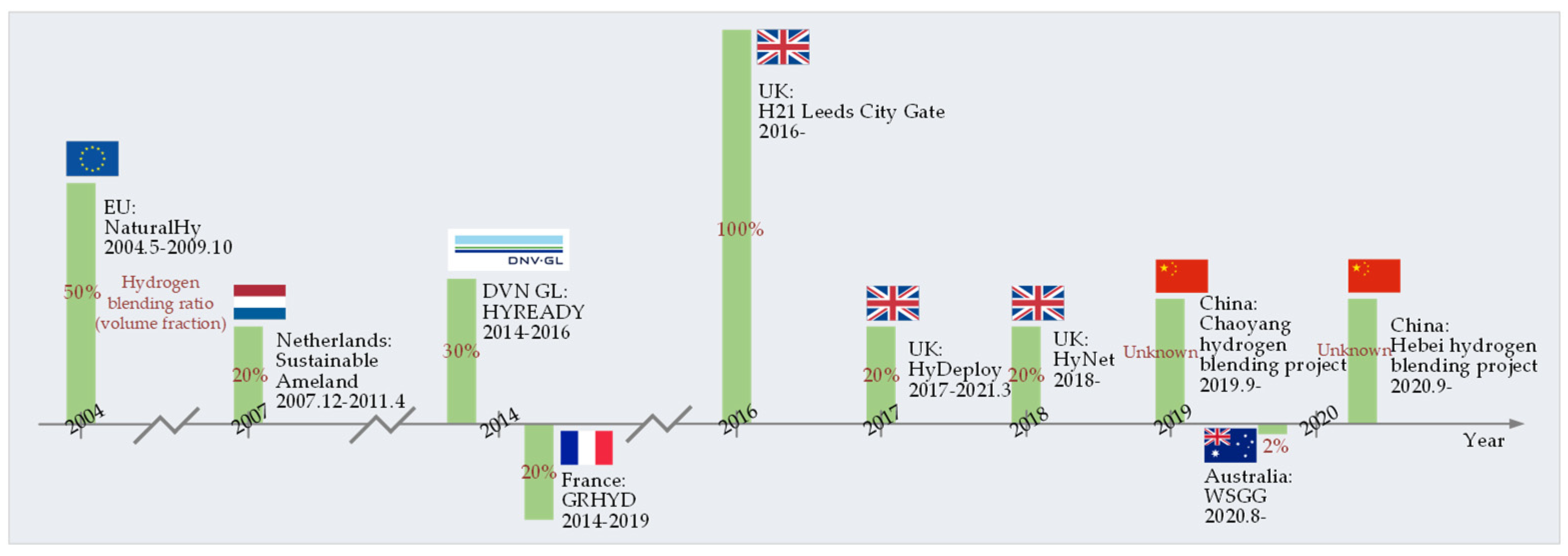
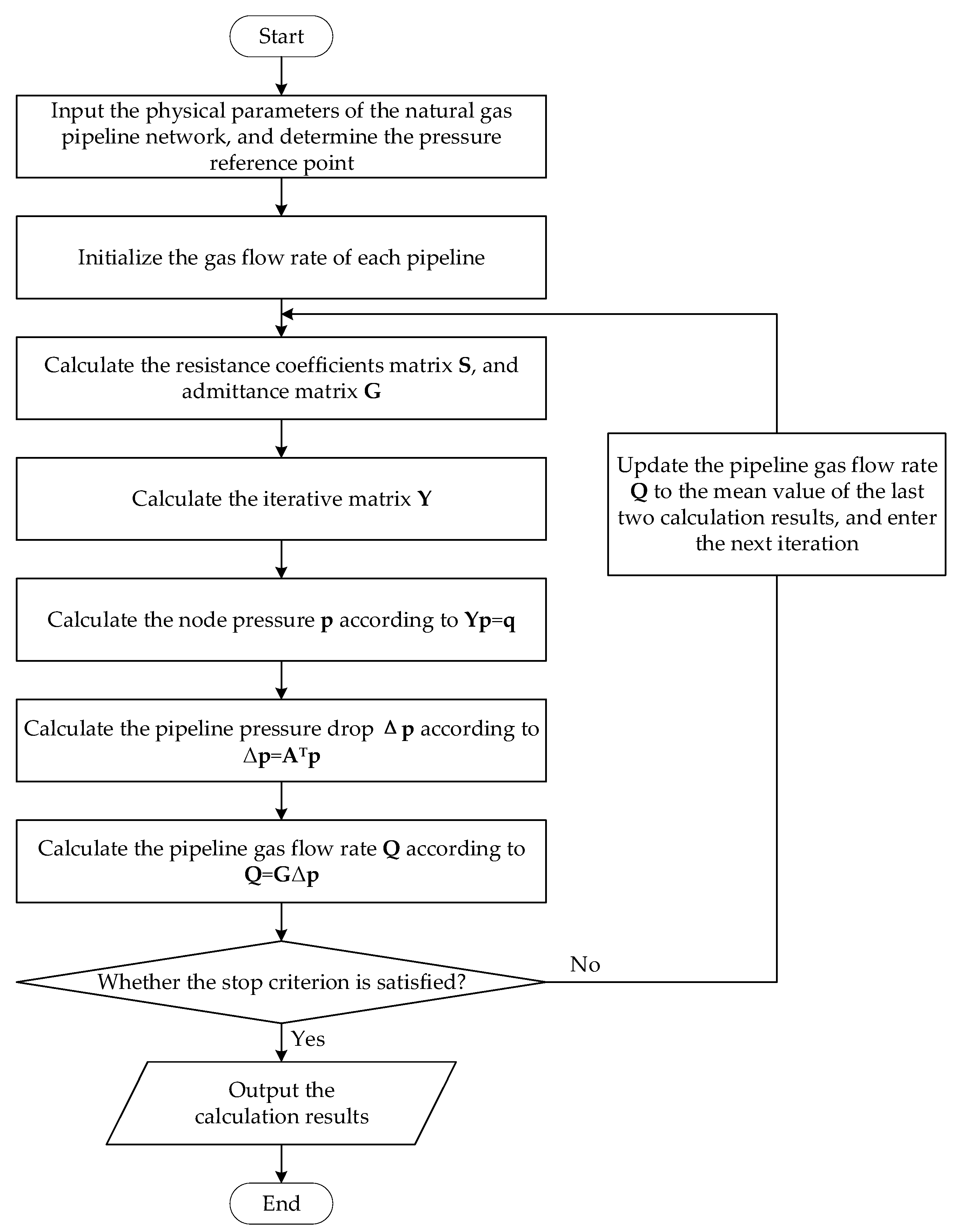

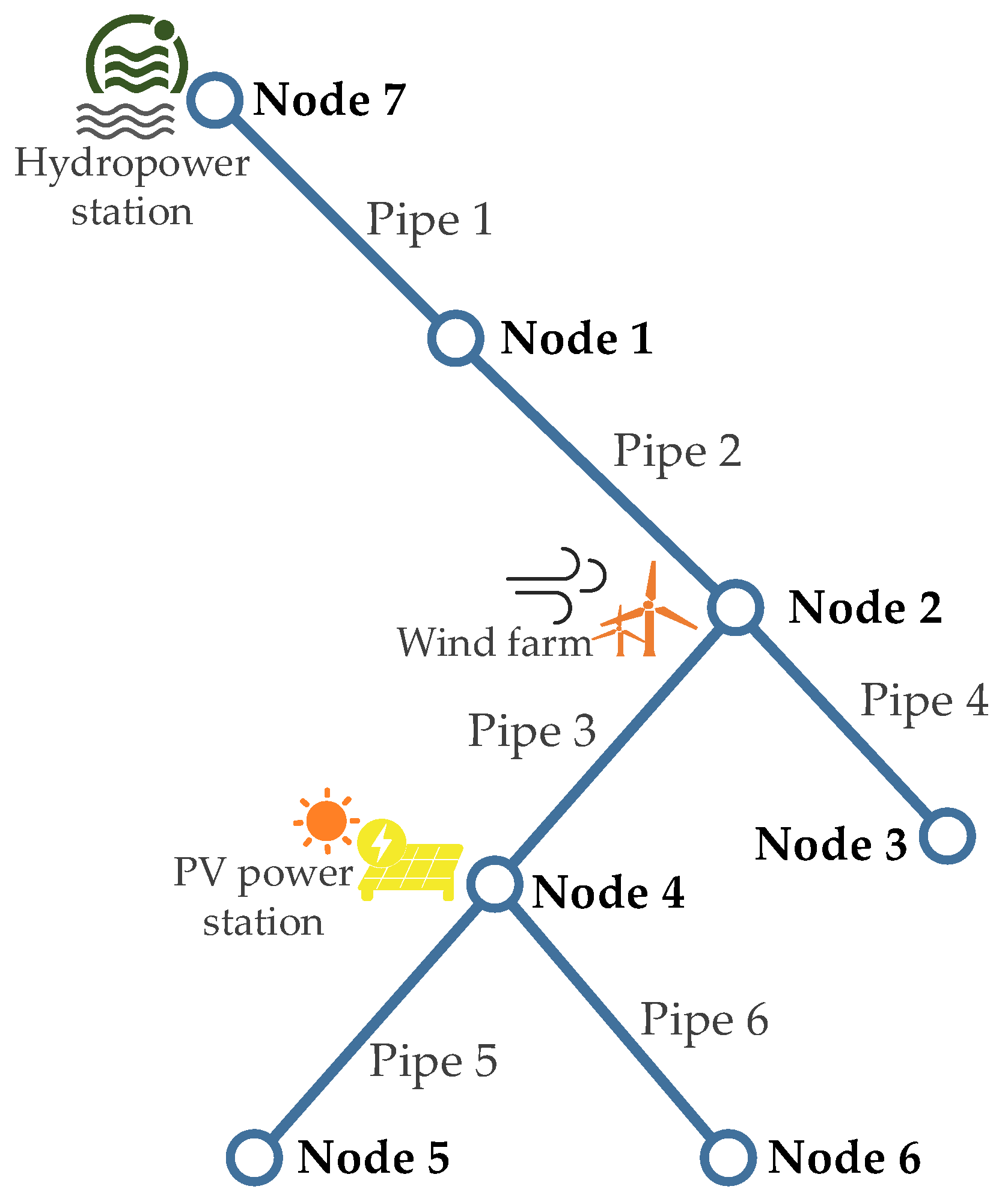

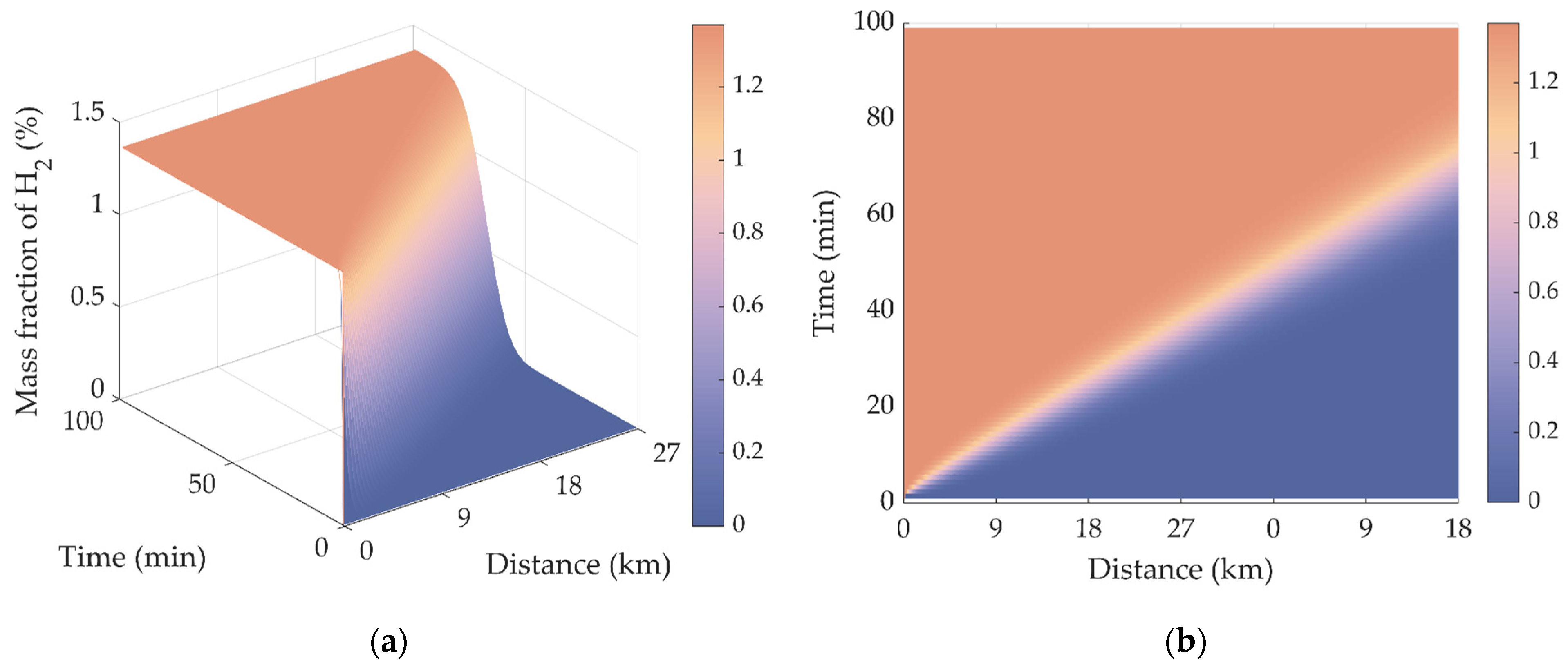


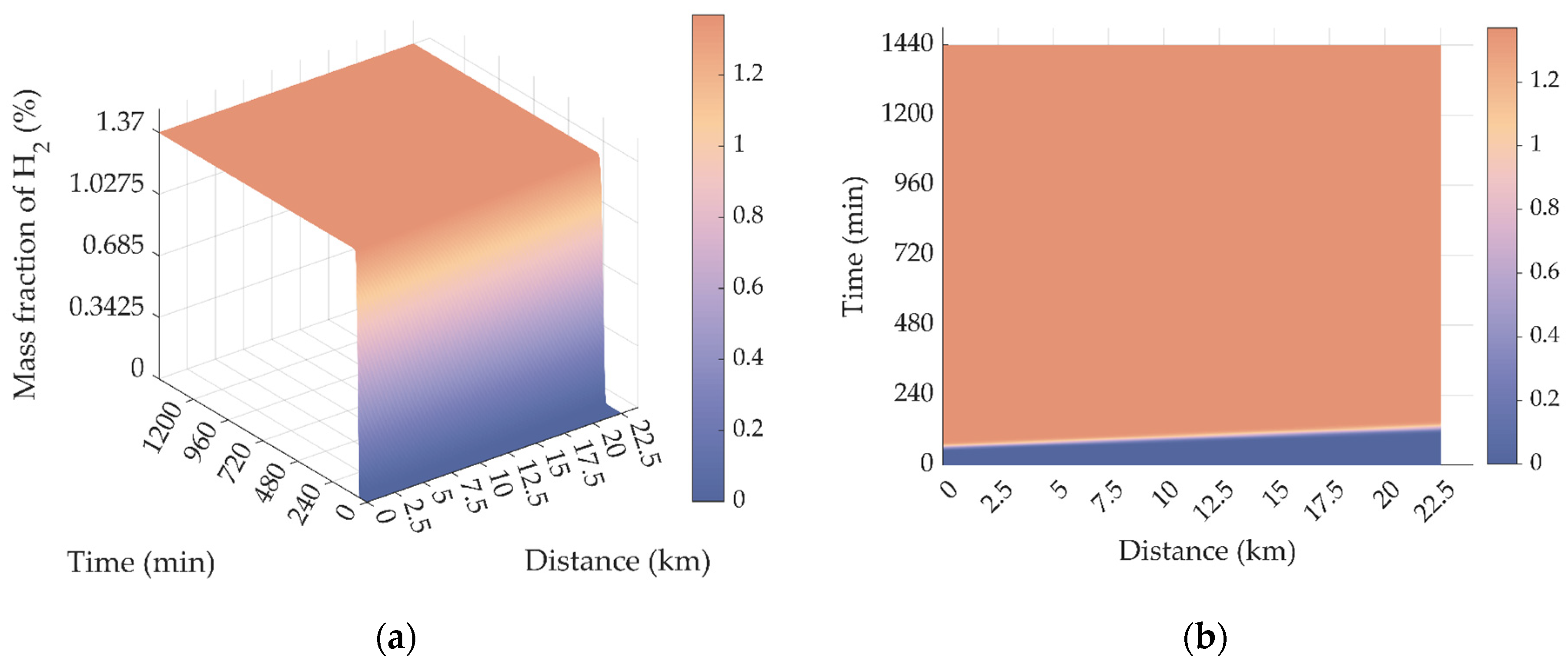
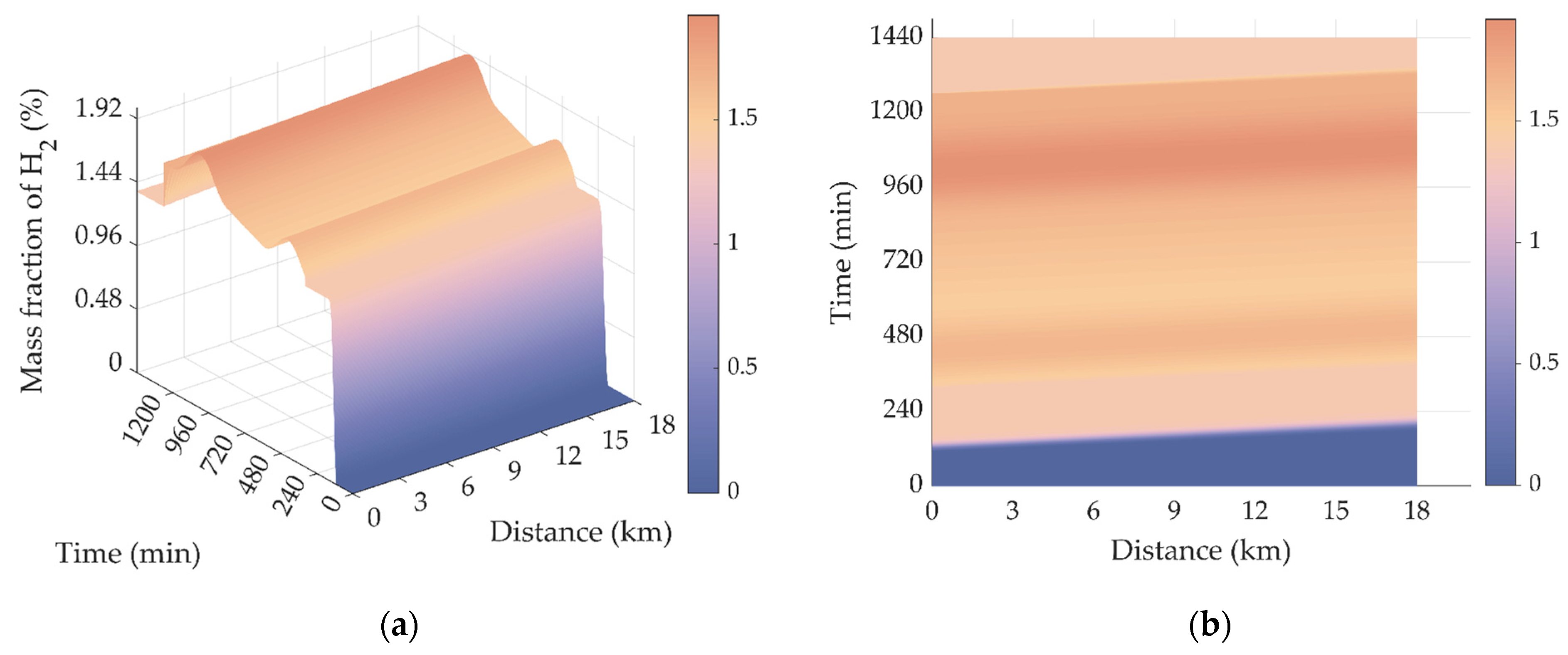
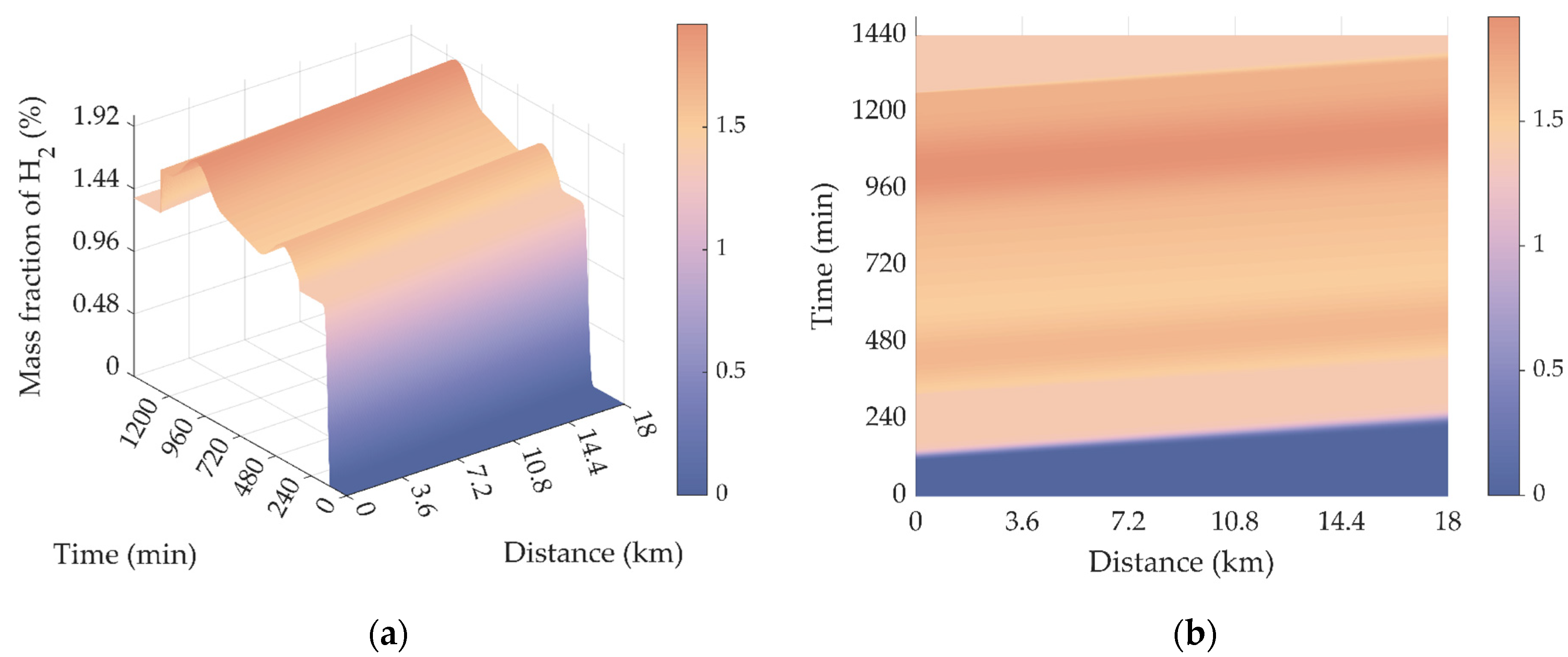
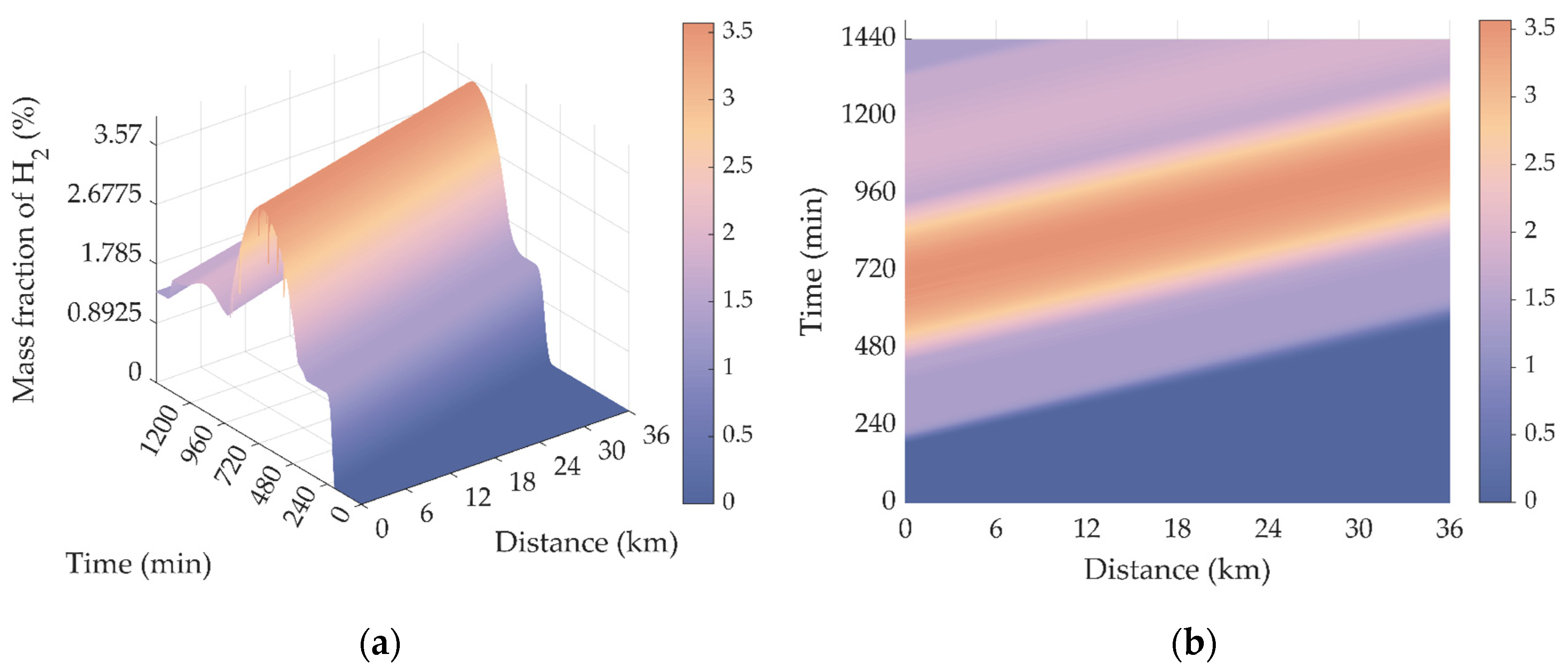
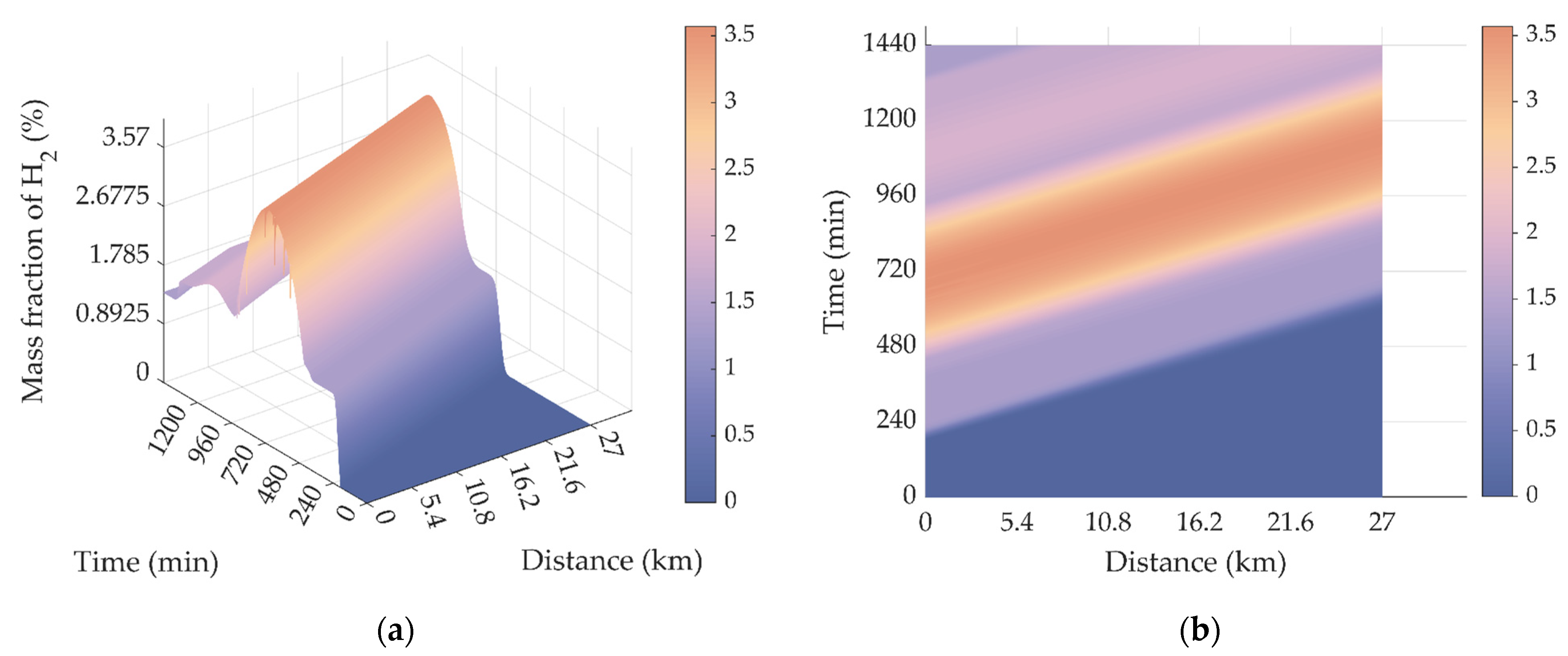
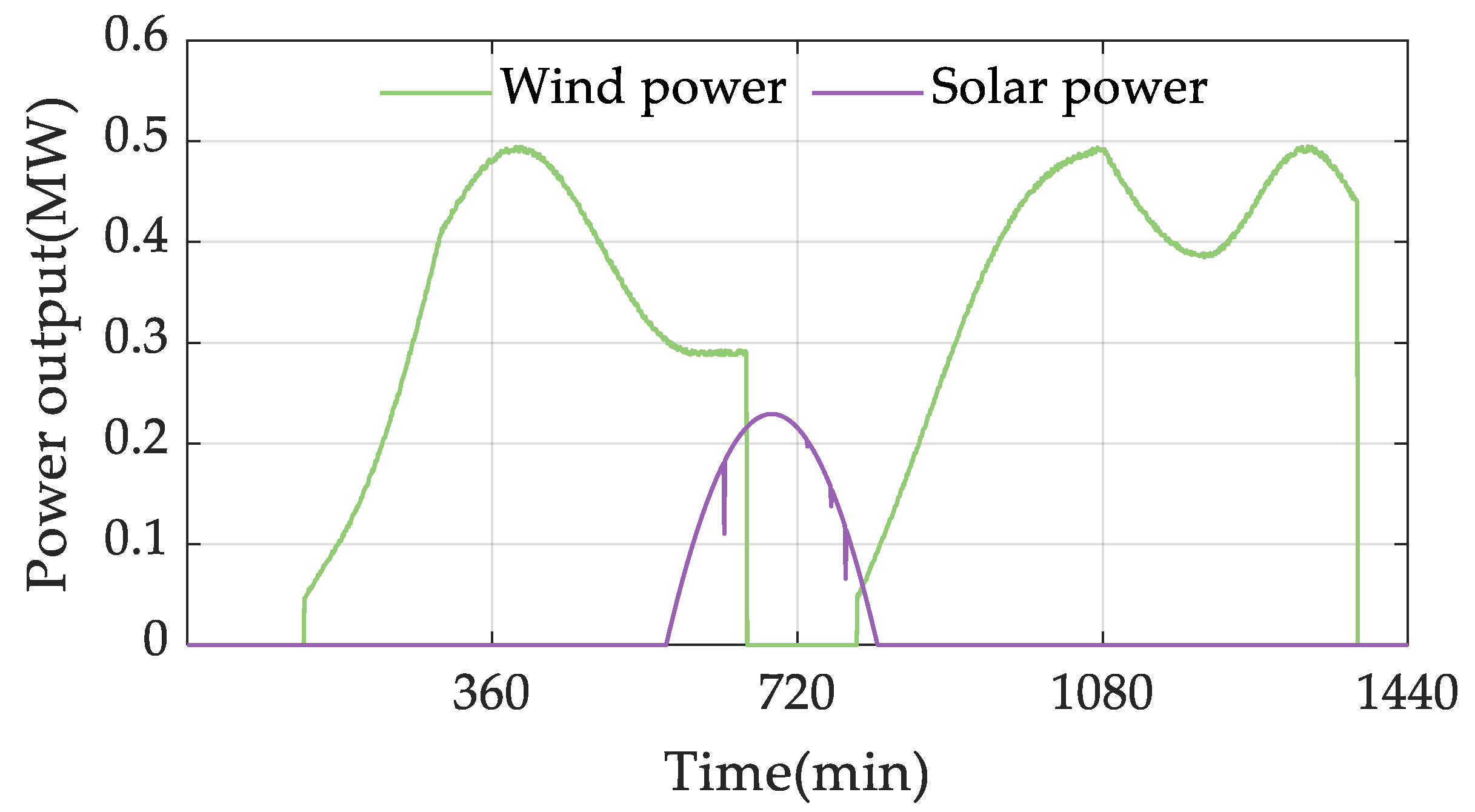
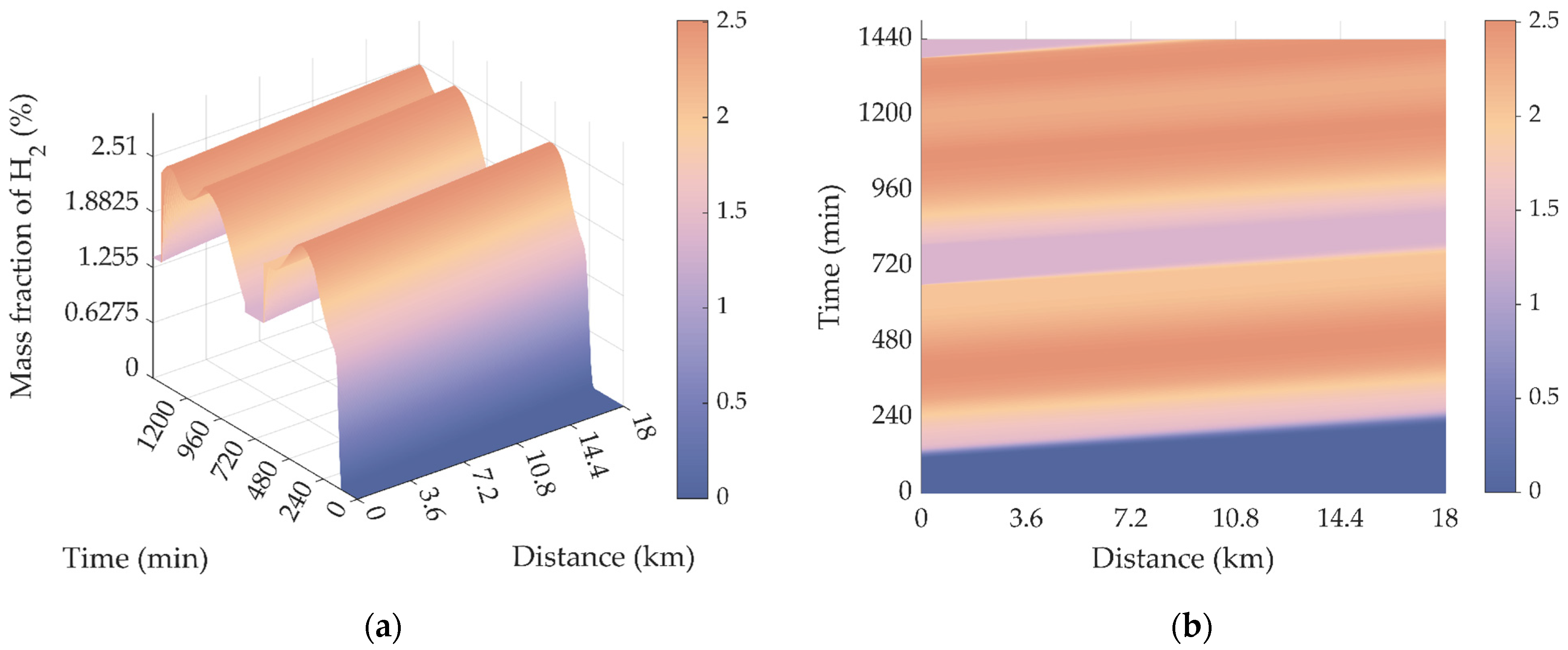
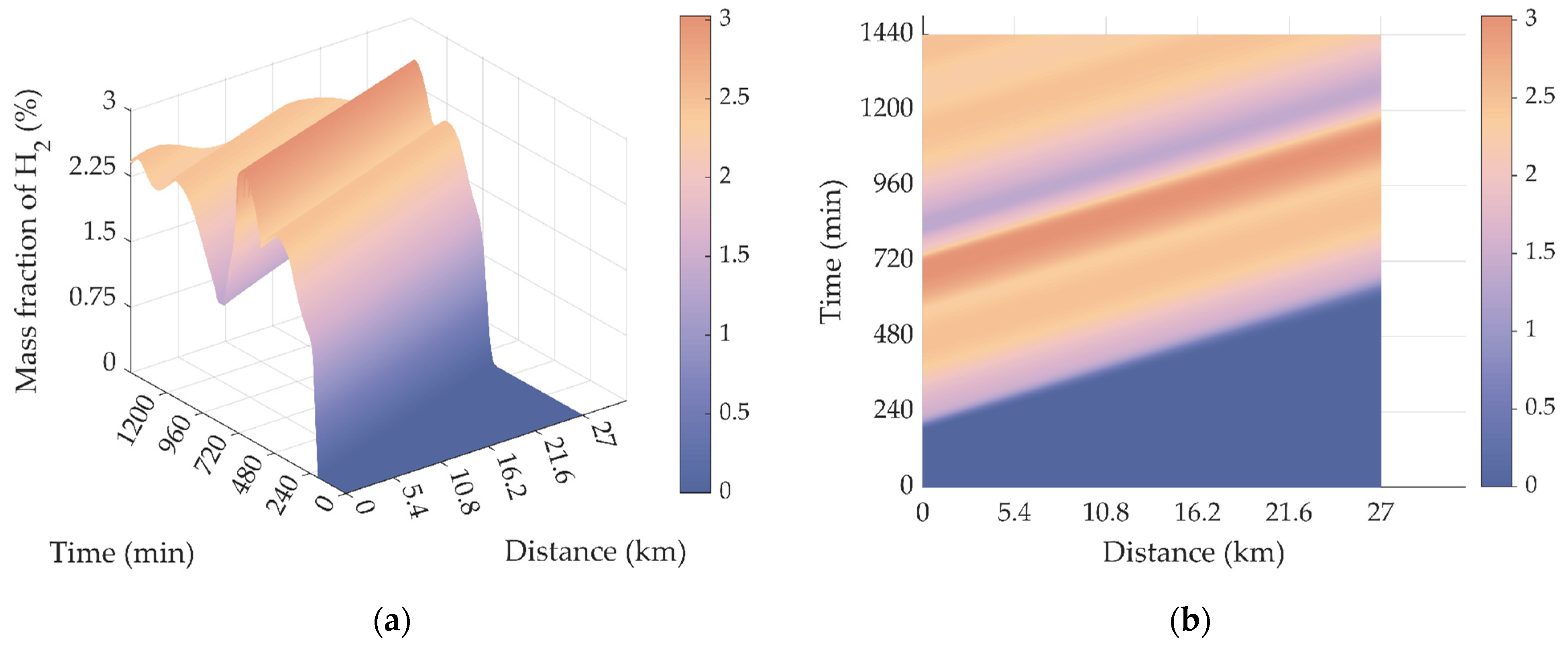


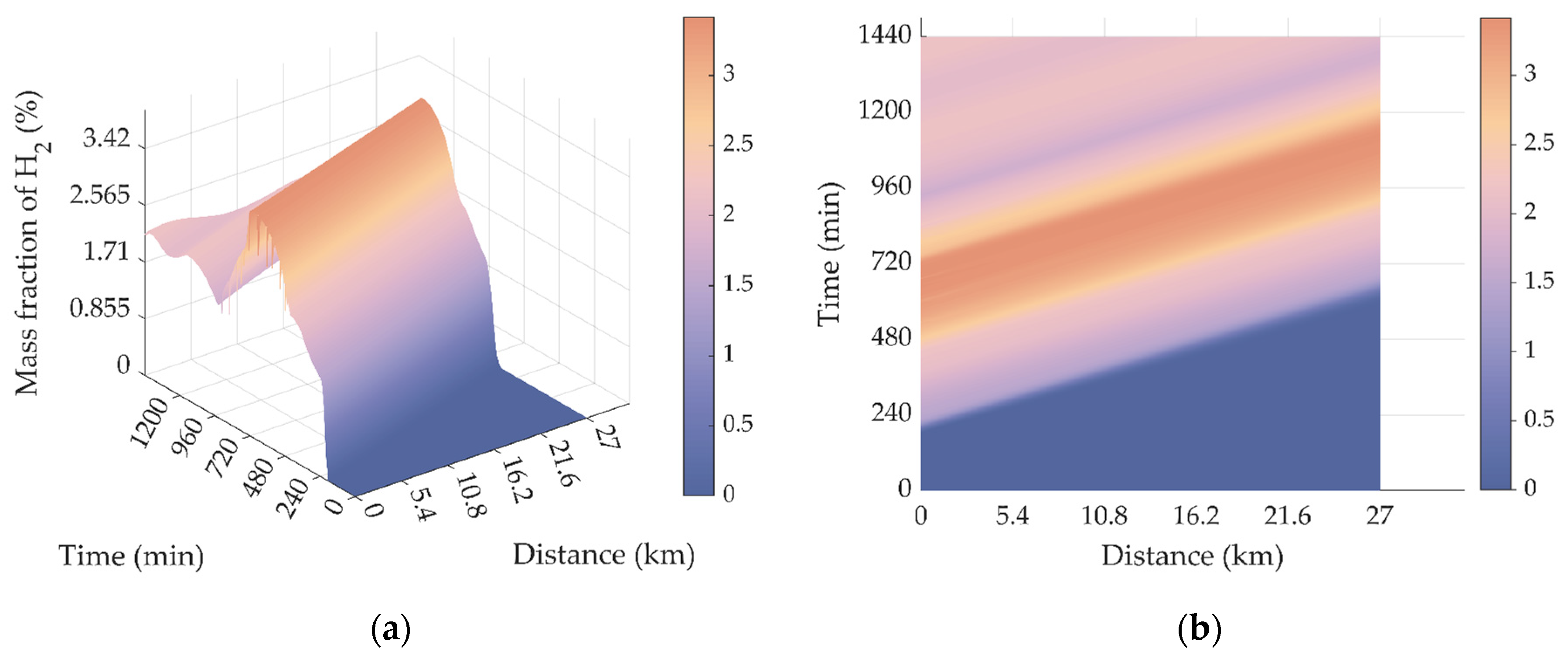

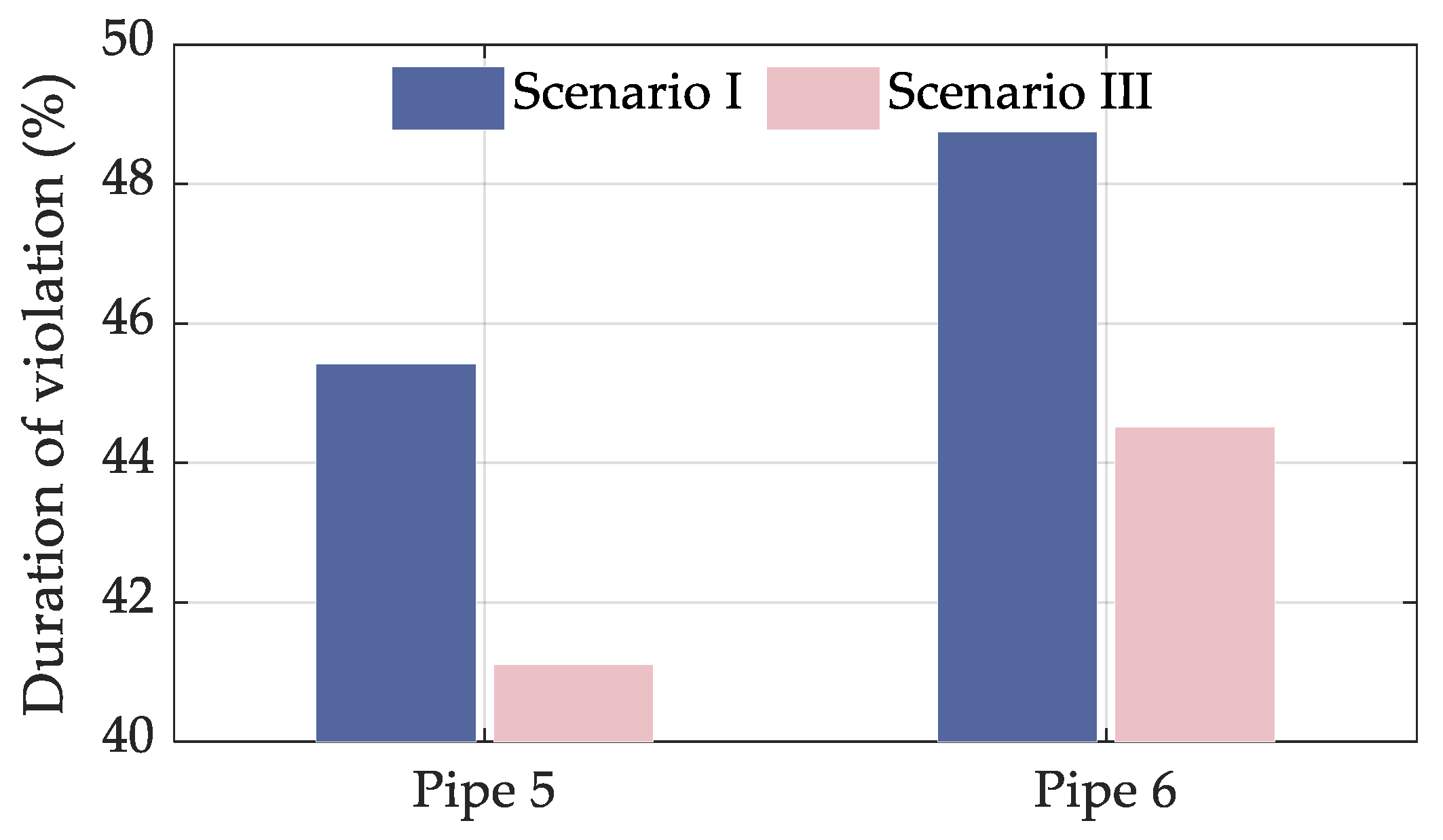
| Pipe No. | Maximum Mass Concentration of H2 (%) | Start Time of Violation | End Time of Violation |
|---|---|---|---|
| 1 | 1.37 | - | - |
| 2 | 1.37 | - | - |
| 3 | 1.92 | - | - |
| 4 | 1.92 | - | - |
| 5 | 3.57 | 556 min/09:16 | 1210 min/20:10 |
| 6 | 3.57 | 556 min/09:16 | 1258 min/20:58 |
| Pipe No. | Maximum Mass Concentration of H2(%) | Start Time of Violation | End Time of Violation |
|---|---|---|---|
| 1 | 1.37 | - | - |
| 2 | 1.37 | - | - |
| 3 | 2.51 | - | - |
| 4 | 2.51 | - | - |
| 5 | 3.03 | - | - |
| 6 | 3.03 | - | - |
| Pipe No. | Maximum Mass Concentration of H2(%) | Start Time of Violation | End Time of Violation |
|---|---|---|---|
| 1 | 1.37 | - | - |
| 2 | 1.37 | - | - |
| 3 | 2.20 | - | - |
| 4 | 2.20 | - | - |
| 5 | 3.42 | 537 min/08:57 | 1131 min/18:51 |
| 6 | 3.42 | 537 min/08:57 | 1180 min/19:40 |
Publisher’s Note: MDPI stays neutral with regard to jurisdictional claims in published maps and institutional affiliations. |
© 2022 by the authors. Licensee MDPI, Basel, Switzerland. This article is an open access article distributed under the terms and conditions of the Creative Commons Attribution (CC BY) license (https://creativecommons.org/licenses/by/4.0/).
Share and Cite
Qiu, Y.; Zhou, S.; Chen, J.; Wu, Z.; Hong, Q. Hydrogen-Enriched Compressed Natural Gas Network Simulation for Consuming Green Hydrogen Considering the Hydrogen Diffusion Process. Processes 2022, 10, 1757. https://doi.org/10.3390/pr10091757
Qiu Y, Zhou S, Chen J, Wu Z, Hong Q. Hydrogen-Enriched Compressed Natural Gas Network Simulation for Consuming Green Hydrogen Considering the Hydrogen Diffusion Process. Processes. 2022; 10(9):1757. https://doi.org/10.3390/pr10091757
Chicago/Turabian StyleQiu, Yue, Suyang Zhou, Jinyi Chen, Zhi Wu, and Qiteng Hong. 2022. "Hydrogen-Enriched Compressed Natural Gas Network Simulation for Consuming Green Hydrogen Considering the Hydrogen Diffusion Process" Processes 10, no. 9: 1757. https://doi.org/10.3390/pr10091757
APA StyleQiu, Y., Zhou, S., Chen, J., Wu, Z., & Hong, Q. (2022). Hydrogen-Enriched Compressed Natural Gas Network Simulation for Consuming Green Hydrogen Considering the Hydrogen Diffusion Process. Processes, 10(9), 1757. https://doi.org/10.3390/pr10091757








